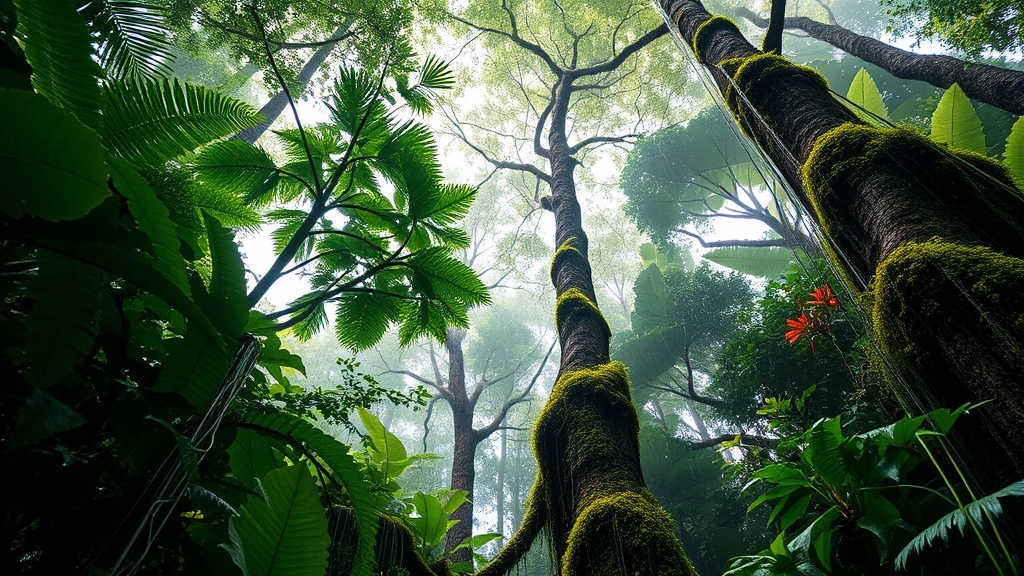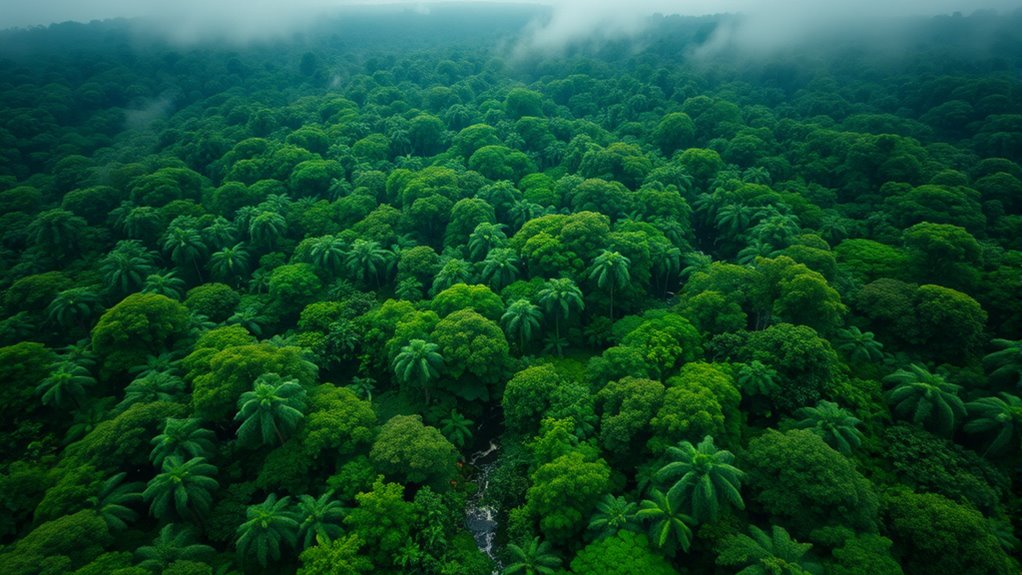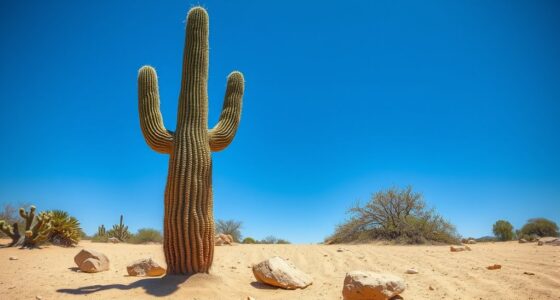Rainforests are often called the lungs of the Earth because they produce about 20% of the oxygen you breathe and help control greenhouse gases. However, ongoing deforestation threatens these essential ecosystems, disrupting climate balance, reducing biodiversity, and harming countless species. As these forests shrink, their ability to absorb carbon decreases, accelerating climate change. If you want to understand how protecting rainforests can secure our planet’s future, keep exploring this urgent topic.
Key Takeaways
- Rainforests produce about 20% of the world’s oxygen and act as vital carbon sinks, supporting planetary health.
- Deforestation destroys habitats, leading to biodiversity loss and threatening countless species.
- Habitat destruction disrupts ecological balance, reducing rainforest resilience and impacting global climate regulation.
- Loss of rainforests affects rainfall patterns, accelerates climate change, and threatens agriculture and water resources worldwide.
- Protecting rainforests is crucial for preserving biodiversity, ecological stability, and ensuring a sustainable future for Earth.

Have you ever wondered why rainforests are often called the “lungs of the Earth”? It’s because they produce about 20% of the oxygen we breathe, acting as essential filters that absorb carbon dioxide and release fresh air. However, this fundamental role is increasingly under threat. Deforestation impacts these forests profoundly, stripping away vast areas of lush greenery and disrupting the delicate balance that sustains life. When trees are cut down, not only do we lose the capacity to absorb greenhouse gases, but we also threaten countless species that depend on the rainforest for their survival. Deforestation accelerates biodiversity loss by destroying habitats where countless plants, animals, insects, and microorganisms live. Without their homes, many species face extinction, and the intricate web of life that supports the rainforest’s health begins to unravel.
As trees are removed, the forest’s ability to regulate local and global climates diminishes. Rainforests play a critical role in maintaining rainfall patterns and preventing desertification. When large areas are cleared, it leads to reduced rainfall and altered weather systems, which can create a domino effect impacting agriculture and water supplies far beyond the forest itself. The loss of biodiversity isn’t just about losing pretty plants or rare animals; it’s about losing the genetic diversity that could hold the key to medicines, food sources, and ecological resilience. Every tree cut down means fewer opportunities for new discoveries and solutions to health and environmental challenges.
You might think that deforestation is only a local issue, but its impacts ripple worldwide. As the trees vanish, the forest’s capacity to store carbon diminishes, contributing to climate change. The more we cut down, the faster the climate warms, which in turn damages remaining forests and accelerates biodiversity loss even further. This cycle threatens not just the species that call the rainforest home but also human populations that depend on these ecosystems for their livelihoods and well-being. Protecting rainforests isn’t just about saving trees; it’s about preserving the complex ecosystems that sustain life on Earth. Every effort to curb deforestation helps keep these forests healthy, ensuring they continue playing their essential role as the planet’s lungs.
A crucial aspect of maintaining rainforest health is understanding the importance of biodiversity and how it affects the resilience of ecological systems, much like how preserving biodiversity ensures ecological stability. Recognizing the impacts of deforestation and actively working to reduce biodiversity loss is indispensable. If we continue on this destructive path, we risk losing irreplaceable natural treasures and compromising the very air we breathe. But if we take steps to protect these critical ecosystems, we can help ensure that rainforests remain resilient, vibrant, and capable of supporting life for generations to come.
Frequently Asked Questions
How Do Rainforests Influence Global Weather Patterns?
You might not realize it, but rainforests play a crucial role in influencing global weather patterns. They help with climate regulation by absorbing carbon dioxide and releasing moisture into the atmosphere, which affects rainfall worldwide. Their biodiversity impact is significant, as diverse species support healthy ecosystems that sustain these processes. When rainforests are threatened, it disrupts climate stability and reduces biodiversity, ultimately impacting weather patterns on a global scale.
What Are the Main Causes of Rainforest Deforestation?
You might think deforestation happens mainly from natural causes, but human activities are the main culprits. Logging impacts forests directly by removing trees, and agricultural expansion pushes land clearing for crops or livestock. These activities often occur together, accelerating forest loss. By understanding that human-driven logging impacts and agricultural expansion are the primary causes, you realize how essential it is to support sustainable practices to protect these critical ecosystems.
How Do Indigenous Peoples Depend on Rainforests?
You depend on rainforests because indigenous peoples rely on their resources for food, medicine, and shelter. Your traditional practices and indigenous knowledge help sustainably manage these ecosystems, ensuring their health. You use medicinal plants and hunting techniques passed down through generations, maintaining a balance with nature. By respecting indigenous ways, you support the preservation of rainforests and their essential biodiversity, recognizing their critical role in the planet’s well-being.
Can Rainforest Regeneration Occur Naturally After Destruction?
You might wonder if rainforest regeneration can happen naturally after destruction. It’s possible, thanks to ecological resilience, where ecosystems recover through natural recovery processes. Sometimes, rainforests bounce back if the damage isn’t too severe or if the seed bank remains intact. However, human activities often hinder this process, making active conservation essential. Protecting remaining forests helps maintain their natural ability to recover and preserves biodiversity.
What Role Do Rainforests Play in Carbon Sequestration?
You might wonder how rainforests help fight climate change. They play a crucial role in carbon sequestration by storing large amounts of carbon in their trees and soil. This process enhances forest resilience, allowing ecosystems to recover from damage. When rainforests thrive, they act as natural carbon sinks, reducing greenhouse gases in the atmosphere. Protecting these forests is essential for maintaining global carbon storage and combating climate change effectively.
Conclusion
If you think rainforests are mere trees, think again — they’re the heartbeat of the planet, the lungs that breathe life into every living thing. Lose them, and you risk releasing chaos so vast, it could swallow the Earth’s future whole. Your actions matter more than you realize; a single choice could tip the scales from thriving paradise to irreversible disaster. Protect these fragile giants, or face a world unrecognizably scarred and silenced forever.






